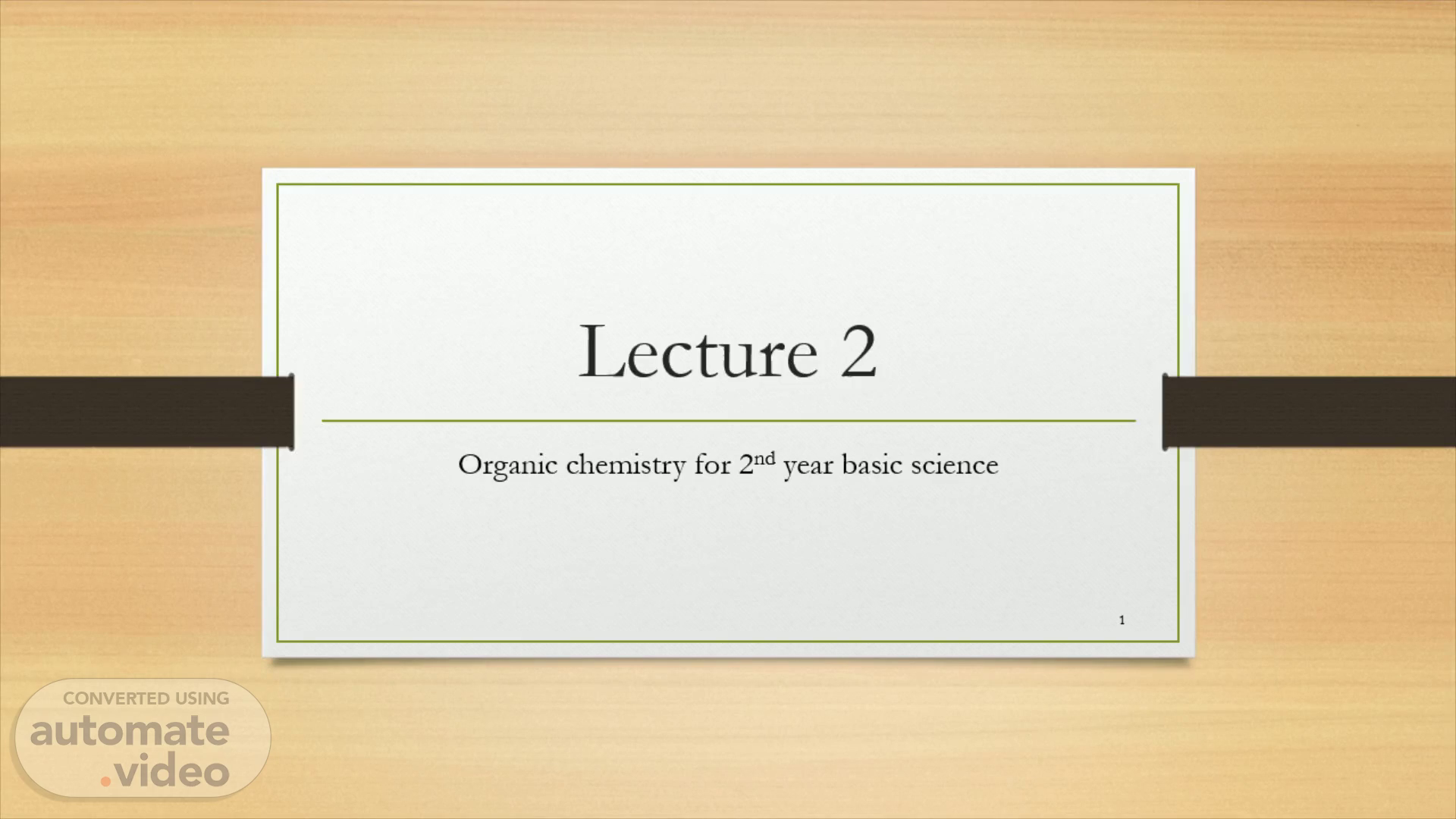Scene 1 (0s)
Lecture 2. Organic chemistry for 2 nd year basic science.
Scene 2 (7s)
Revision on the previous lecture. 2. Table Description automatically generated.
Scene 3 (14s)
0.1435 gm of an organic compound containing C, H and O. On analysis gave 0.3235 gm of CO 2 and 0.1339 gm of water. Calculate the % of C and H and O, then calculate the E.F and M.F knowing that the molecular wt of the compound is 174..
Scene 4 (41s)
C H O 61.83/12 10.37/1 27.8/16 5.1/1.7 10.37/1.7 1.7/1.7 3 6.1 1 Thus the Empirical formula is C 3 H 6 O M. F = n X E.F and n= M.wt / E.f wt = 174/58=3 M.f = 3 X C 3 H 6 O = C 9 H 18 O 3.
Scene 5 (1m 1s)
Hybridization of Carbon. Hybridization of Carbon – Carbon is one of the important and most common chemical element that is essential for organic connections. Carbon atoms usually form bonds by mixing different orbitals and can contribute to the formation of different structures and properties. Most of the time the s and p orbitals of the second shell in carbon combine together during hybridization. In essence, carbon can use different hybridization to form different compounds..
Scene 6 (1m 23s)
Electron configuration in carbon atom. Diagram Description automatically generated.
Scene 7 (1m 32s)
Types of Hybridization in Carbon. Hybridization Of Carbon.
Scene 8 (1m 42s)
Diagram Description automatically generated. 8.
Scene 9 (1m 48s)
A picture containing clock Description automatically generated.
Scene 10 (1m 57s)
Diagram Description automatically generated. 10. Diagram, schematic Description automatically generated.
Scene 11 (2m 5s)
A picture containing timeline Description automatically generated.
Scene 12 (2m 11s)
How To Determine Hybridization:. Count the number of atoms connected to it (atoms – not bonds!) Count the number of lone pairs attached to it. Add these two numbers together. If it’s 4, your atom is sp 3 . If it’s 3, your atom is sp 2 . If it’s 2, your atom is sp. (If it’s 1, it’s probably hydrogen!) sp 3 hybridization: sum of attached atoms + lone pairs = 4.
Scene 13 (2m 34s)
sp 3 hybridization : sum of attached atoms + lone pairs = 4.
Scene 14 (2m 46s)
sp 2 hybridization : sum of attached atoms + lone pairs = 3.
Scene 15 (2m 56s)
sp hybridization : sum of attached atoms + lone pairs = 2.
Scene 16 (3m 7s)
Bond Polarity and Electronegativity. The electron pairs shared between two atoms are not necessarily shared equally. For example, while the bonding electron pair is shared equally in the covalent bond in Cl 2 , in NaCl the 3s electron is stripped from the Na atom and is incorporated into the electronic structure of the Cl atom and the compound is most accurately described as consisting of individual Na + and Cl − ions (ionic bonding). For most covalent substances, their bond character falls between these two extremes. As demonstrated below, the bond polarity is a useful concept for describing the sharing of electrons between atoms within a covalent bond: A nonpolar covalent bond is one in which the electrons are shared equally between two atoms. A polar covalent bond is one in which one atom has a greater attraction for the electrons than the other atom . If this relative attraction is great enough, then the bond is an ionic bond..
Scene 17 (3m 48s)
Chart, bubble chart Description automatically generated.
Scene 18 (3m 57s)
Chart, bubble chart Description automatically generated.
Scene 19 (4m 4s)
Electronegativity is defined as the ability of an atom in a particular molecule to attract electrons to itself. The greater the value, the greater the attractiveness for electrons. Because the tendency of an element to gain or lose electrons is so important in determining its chemistry, various methods have been developed to quantitatively describe this tendency. Elements with high electronegativities tend to acquire electrons in chemical reactions and are found in the upper right corner of the periodic table. Elements with low electronegativities tend to lose electrons in chemical reactions and are found in the lower left corner of the periodic table..
Scene 20 (4m 34s)
Electronegativity values of elements in the periodic table.
Scene 21 (4m 42s)
What is Homolytic Fission?. Homolytic fission (sometimes referred to as hemolysis) is a type of bond fission that involves the dissociation of a given molecule wherein one electron is retained by each of the original fragments of the molecule. Therefore, when a neutrally charged molecule is subjected to homolytic fission, two free radicals are obtained as the product (since each of the chemical species retains one electron from the bond pair)..
Scene 22 (5m 4s)
What is Heterolytic Fission?. Heterolytic fission, also known as heterolysis, is a type of bond fission in which a covalent bond between two chemical species is broken in an unequal manner, resulting in the bond pair of electrons being retained by one of the chemical species (while the other species does not retain any of the electrons from the bond pair). When a neutrally charged molecule undergoes heterolytic fission, one of the products will have a positive charge whereas the other product will have a negative charge..
Scene 23 (5m 27s)
Quizz. Determine the empirical formula for methyl acetate, which has the following chemical analysis: 48.64% carbon, 8.16% hydrogen, and 43.20% oxygen..
